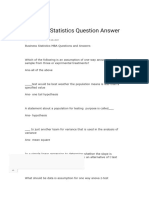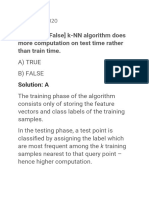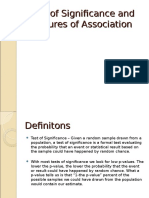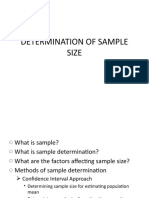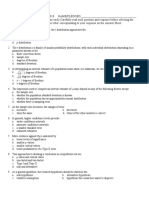Assignment #3 Hypothesis Testing
Uploaded by
Jihen SmariAssignment #3 Hypothesis Testing
Uploaded by
Jihen SmariAssignment #3: Hypothesis testing
Due on November 2, 2017
Course Title: Business Statistics II
MCQs
1. A statement about the value of a population parameter is called:
a. Null hypothesis
b. Alternative hypothesis
c. Simple hypothesis
d. Composite hypothesis
2. A rule or formula that provides a basis for testing a null hypothesis is
called:
a. Population statistic
b. Test-statistic
c. Both of these
d. None of the above
3. An advertising agency wants to test the hypothesis that the proportion of
adults in Tunisia who read a “La Presse” newspaper is 25 percent. The null
hypothesis is that the proportion reading “La Presse” is:
a. Different from 25%
b. Equal to 25%
c. Less than 25 %
d. More than 25 %
4. In hypothesis testing, a Type 2 error occurs when
Business Statistics II Fall 2017-18 Page 1/9
a. The null hypothesis is not rejected when the null hypothesis is true
b. The null hypothesis is rejected when the null hypothesis is true
c. The null hypothesis is not rejected when the alternative hypothesis is
true
d. The null hypothesis is rejected when the alternative hypothesis is
true.
5. A hypothesis test is done in which the alternative hypothesis is that more
than 10% of a population is left-handed. The p-value for the test is
calculated to be 0.25. Which statement is correct?
a. We can conclude that more than 10% of the population is left-handed
b. We can conclude that more than 25% of the population is left-handed
c. We can conclude that exactly 25% of the population is left-handed
d. We cannot conclude that more than 10% of the population is left-
handed.
6. The form of the alternative hypothesis can be:
a. one-tailed
b. two-tailed
c. neither one nor two-tailed
d. one or two-tailed
7. The following is not needed to be known in order to compute the p-value:
a. Knowledge of whether the test is one-tailed or two tailed
b. The value of the test statistic
c. The level of significance
d. All of the above are needed
8. In hypothesis testing,
a. the smaller the Type I error, the smaller the Type II error will be
b. the smaller the Type I error, the larger the Type II error will be
c. Type II error will not be effected by Type I error
Business Statistics II Fall 2017-18 Page 2/9
d. The sum of Type I and Type II errors must equal to 1
9. In a two-tailed hypothesis test situation (testing a mean assuming σ is
known), the value of the test statistic is determined to be Z obs = -2.692.
The sample size has been 45. The p-value for this test is
a. -0.0036
b. +0.0036
c. -0.0072
d. +0.0072
10.A manufacturer of car batteries claims that his product will last at least 4
years on average. A sample of 50 is taken and the mean and standard
deviation are found. The test statistic is calculated to be equal to -1.656.
Using a 5% level, the conclusion would be
a. there is sufficient evidence for the manufacturer’s claim to be
considered correct
b. there is insufficient evidence for the manufacturer’s claim to be
considered correct
c. there is sufficient evidence for the manufacturer’s claim to be
considered incorrect
d. there is insufficient evidence for the manufacturer’s claim to be
considered incorrect
11.A drink vending machine is adjusted so that, on average, it dispenses 220
mls of fruit juice (with a standard deviation of 10 mls) into a plastic cup.
However, the machine has a tendency to go out of adjustment and
periodic checks are made to determine the average amount of fruit juice
actually being dispensed. A sample of 45 drinks is taken to test the
adjustment of the machine. For α = 0.05, an appropriate decision rule
would be
a. reject the null if the calculated Zobs > 1.96
b. do not reject the null if |Zobs| is < 1.96
c. reject the null if the calculated Zobs ≠ 1.96
d. reject the null if the calculated Zobs > |1.96|
Business Statistics II Fall 2017-18 Page 3/9
12.A sample of 40 cows is drawn to estimate the mean weight of a large herd
of cattle. If the standard deviation of the sample is 96 kg, what is the
maximum error in a 90% confidence interval estimate?
a. 30 kg
b. 58 kg
c. 25 kg
d. 1.645 kg
13.In a hypothesis test:
e. the null hypothesis is what we are trying to prove
f. the alternate hypothesis is always assumed to be true
g. the alternate hypothesis is accepted unless there is sufficient
evidence to say otherwise
h. the null hypothesis is not rejected unless there is sufficient evidence
to reject it.
14.A 0.05 level of significance means that
a. There is only a 5% chance that the statistic's value could be obtained
as a result of sampling errors only assuming H 0 is true
b. One is 50% certain that the sample value is representative of the
population
c. There is only a 5% chance that the variables tested are not
independent
d. The results can be accepted because the sampling error is only 5%
e. The level of confidence is only 5%
15.A statistical test used to determine whether a correlation coefficient is
statistically significant is called the
a. One-way analysis of variance
b. t-test for independent samples
c. Chi-square test for contingency tables
d. t-test for correlation coefficients
Business Statistics II Fall 2017-18 Page 4/9
16.Suppose that n = 100 and that we want to test whether the population
mean is equal to 20 versus the alternative that it is smaller than 20. The
sample mean is found to be 18 and the sample standard deviation is 10.
Compute the p-value for this test.
a. 0.0228
b. 0.0456
c. 0.5532
d. 1.00
17.To test whether or not two population variances are equal, the appropriate
distribution is:
a. Chi-square distribution
b. F distribution
c. t distribution with n1 + n2 - 2 degrees of freedom
d. None of the above
18.The critical value(s) of the following hypothesis test
H 0 : σ 1=σ 2 ; H 1 : σ 1> σ 2
with n1 = 10 and n2 = 21 is (are) :
a. 2.39
b. – 2.39
c. ± 2.39
d. 2.84 and 1/2.84
19.If there is a very strong correlation between two variables then the
correlation coefficient must be
a. any value larger than 1
b. much smaller than 0 and larger than -1, if the correlation is negative
c. much larger than 0 and smaller than 1, regardless of whether the
correlation is negative or positive
d. None of these alternatives is correct.
A researcher in the field of educational psychology is interested in the effects an
open classroom has on intellectual development. In the open classroom things
Business Statistics II Fall 2017-18 Page 5/9
are much less structured than in a traditional classroom and she believes that
this might affect problem-solving skills. An elementary school in her district
switched to an open classroom format last year, and she is interested to see how
this has impacted on the kids problem-solving skills. She obtains a random
sample of 49 fourth grade children and administers a conceptual problem-solving
test to them. It is known that fourth graders in traditional classes have an
average score of 82 on the test. The children in this study score an average of 86
with a standard deviation of 5. Use this information to answer the following 3
questions.
20.The alternative hypothesis is
a. μ ≠82
b. μ>82
c. μ=82
d. μ<82
21.The test critical value(s) is (are):
a. ±2.010
b. 2.010
c. ±1.677
d. 1.677
22.The test p-value is
a. Smaller 0.001
b. Between 0.005 and 0.001
c. Between 0.005 and 0.01
d. Between 0.01 and 0.025
23.If a hypothesis is not rejected at the 5% level of significance it
a. will never be rejected at the 1% level
b. will always be rejected at the 1% level
c. will sometimes not be accepted at the 1% level
Business Statistics II Fall 2017-18 Page 6/9
d. there is insufficient information to say what will happen at the 1%
level
Exercise #1 (Keller , p. 406)
Because of the enormity of the viewing audience, firms that advertise during the
Super Bowl create special commercials that tend to be quite entertaining. Thirty-
second commercials cost several million dollars during the Super Bowl game. A
random sample of people who watched the game was asked how many
commercials they watched in their entirety. The sample size is equal to 116. Do
these data, see the SPSS file “Xr12-40.sav” and table 1 allow us to infer that the
mean number of commercials watched is greater than 15?
Table 1 : Descriptive Statistics of Commercials
N Minimum Maximum Mean Std. Deviation
Commercials 116 8 37 15,27 5,723
Valid N (listwise) 116
Exercise #2 (Keller, 2012, p. 426)
Has the recent drop in airplane passengers resulted in better on-time
performance? Before the recent economic downturn, one airline baggaged that
92% of its flights were on time. A random sample of 165 flights completed this
year reveals that 153 were on time. Can we conclude at the 5% significance level
that the airline’s on-time performance has improved?
Exercise #3 (Keller 2012 , p. 404)
A federal agency responsible for enforcing laws governing weights and measures
routinely inspects packages to determine whether the weight of the contents is at
least as great as that advertised on the package. A random sample of 18
containers whose packaging states that the contents weigh 8 ounces was drawn.
The contents were weighed, see the SPSS file “Xr12-26.sav”, and the results are
reported in Table 2. Can we conclude at the 1% significance level that on average
the containers are mislabeled? (Hint. Assume that the random variable is
normally distributed)
Table 2 : Descriptive Statistics of Weights
N Minimum Maximum Mean Std. Deviation
Weights 18 7,8 8,1 7,914 ,0847
Business Statistics II Fall 2017-18 Page 7/9
Valid N (listwise) 18
Exercise #4 (Keller 2012, p. 417)
When an election for political office takes place, the television networks cancel
regular programming and instead provide election coverage. When the ballots
are counted, the results are reported. However, for important offices such as
president or senator in large states, the networks actively compute to see which
will be the first to predict a winner. This is done through exit polls, wherein a
random sample of voters who exit the polling booth is asked for whom they
voted. From the data, the sample proportion of voters supporting the candidates
is computed. A statistical technique is applied to determine whether there is
enough evidence to infer that the leading candidate will garner enough votes to
win.
Suppose that in the exit poll from the state of Florida during the 2000 year
elections, the pollsters recorded only the voters of the two candidates who had
any chance of winning. Democrat Albert Gore (code = 1) and the republican
George W. Bush (code = 2). The SPSS file “Xm12-05.sav” contains the data and
Table 3 presents the results. The polls close at 8:00 P. M. A candidate is declared
a winner if the proportion of votes in the entire state for him is larger than 50%.
Can the networks conclude from these data that the Republican candidate will
win the state? (Hint. Propose the adequate hypothesis test using a confidence
level α equal to 0.05)
Table 3 : Votes
Frequency Percent Valid Percent Cumulative
Percent
Albert Gore 358 46,8 46,8 46,8
Valid George W. Bush 407 53,2 53,2 100,0
Total 765 100,0 100,0
Exercise #5
The telephone company wants to investigate the desirability of beginning a
marketing campaign that would offer customers the right to purchase an
additional telephone line at a substantially reduced installation cost. The
campaign will be initiated if there is evidence that more than 20% of the
Business Statistics II Fall 2017-18 Page 8/9
customers would consider purchasing an additional telephone line if it were made
available at a substantially reduced installation cost. A random sample of 500
households is selected. The results indicate that 135 of the households would
purchase the additional telephone line at a reduced installation cost. At the 0.05
level of significance, is there evidence that more than 20% of the customers
would purchase the additional telephone line?
1. What are the null and alternative hypotheses?
2. What is the test statistic and its sampling distribution under the null
hypothesis.
3. Compute the value of the test statistic.
4. At the α = 0.05 level of significance, is there evidence that more than 20%
of the customers would purchase the additional telephone line?
a. Find the critical value(s), state the decision rule and decide.
b. Compute the p value and decide.
Exercise #6
According to an ABC News survey, 40% of Americans do not eat breakfast. A sample of 30 college
students found 16 had skipped breakfast that day. Use the α = 0.05 significance level to check whether
college students are more likely to skip breakfast.
1. What are the population and the variable(s) of interest and the parameter(s)?
2. What are the null and alternative hypotheses?
3. What are the test statistic and its sampling distribution?
4. Compute the critical value(s). Use table 1.
5. Compute the value of the test statistic and decide.
6. Compute the p value of the hypothesis test using table 1.
Exercise #7
A company with a large fleet of cars hopes to keep gasoline costs down and sets a goal of attaining a
fleet average of at least 26 miles per gallon. To see if the goal is being met, they check the gasoline
usage for 50 company trips chosen at random, finding a mean of 25.02 mpg and a standard deviation
of 4.83 mpg. Is this strong evidence that they have failed to attain their fuel economy goal?
1. Write appropriate hypotheses.
2. Define the hypothesis test, the test statistic and its null distribution?
3. Find the critical value(s).
4. Compute the value of the test statistic and decide.
5. Approximate the p value of the hypothesis test.
Exercise #8
Business Statistics II Fall 2017-18 Page 9/9
The personal manager for a large airline has claimed that, on average, workers are asked to work no
more than 3 hours overtime per week. Past studies show the standard deviation in overtime hours per
worker to be 1.2 hours.
Suppose that the union negotiators wish to test this claim by sampling payroll records for 250
employees. They believe that the personal manager’s claim is untrue but want to base their conclusion
on the sample results.
1. What are the population, the variable and the parameter of interest in this case?
2. State the null and alternative hypotheses. Define the hypothesis test (test statistic and its
distribution)
3. Discuss the meaning of a type I error and a type II error in the context of this case. ( don’t
exceed 10 lines)
4. Establish the appropriate decision rule if the union wishes to have no more than 0.01 chance
of making a type I error.
5. The payroll records produced a sample mean of 3.15 hours. Do the union negotiators have a
basis for grievance against the airline?
6. Compute the p value.
References
Keller, G. (2012). Managerial Statistics. 9th edition. Cengage Learning.
Business Statistics II Fall 2017-18 Page 10/9
You might also like
- Handleiding Spss Multinomial Logit RegressionNo ratings yetHandleiding Spss Multinomial Logit Regression35 pages
- Assignment-Based Subjective Questions/AnswersNo ratings yetAssignment-Based Subjective Questions/Answers3 pages
- Social & Economic Statistics (Chapter 1 - 5)No ratings yetSocial & Economic Statistics (Chapter 1 - 5)71 pages
- Ch08 Sampling Methods and The Central Limit TheoremNo ratings yetCh08 Sampling Methods and The Central Limit Theorem13 pages
- Statistical Inference and Hypothesis TestingNo ratings yetStatistical Inference and Hypothesis Testing34 pages
- Business Statistics Question Answer MBA First Semester-1No ratings yetBusiness Statistics Question Answer MBA First Semester-159 pages
- Tests of Significance and Measures of AssociationNo ratings yetTests of Significance and Measures of Association21 pages
- Quiz 9 Hypothesis Testing For Two Populations100% (1)Quiz 9 Hypothesis Testing For Two Populations29 pages
- Theory Session: Introduction To BiostatisticsNo ratings yetTheory Session: Introduction To Biostatistics22 pages
- Chapter 8 The Comparison of Two Populations: True/False Questions100% (1)Chapter 8 The Comparison of Two Populations: True/False Questions20 pages
- Classification Metrics in Machine LearningNo ratings yetClassification Metrics in Machine Learning6 pages
- Kode B: Final Exam Second Semester 2019/2020100% (2)Kode B: Final Exam Second Semester 2019/202012 pages
- Aplia PROD SRVMaterialswoody - Hughes 0018 f10 - Test3 - 111510No ratings yetAplia PROD SRVMaterialswoody - Hughes 0018 f10 - Test3 - 1115105 pages
- Chapter 11: Corporations: Organization, Share Transactions, Dividends, and Retained EarningsNo ratings yetChapter 11: Corporations: Organization, Share Transactions, Dividends, and Retained Earnings57 pages
- The Service Sector Is An Important Component of Any CountryNo ratings yetThe Service Sector Is An Important Component of Any Country2 pages
- TD1 - Time Value of Money 2018 (Solution) PDFNo ratings yetTD1 - Time Value of Money 2018 (Solution) PDF9 pages
- Chap2. (Students) Discounted CF Applications (Capital Budgeting)No ratings yetChap2. (Students) Discounted CF Applications (Capital Budgeting)45 pages
- CH 7 Statistical Data Treatment and EvaluationNo ratings yetCH 7 Statistical Data Treatment and Evaluation30 pages
- Sample Size (N) P 0.05 4 5 6 7 8 9 10 11 12 13 14 15: Spearman Rank-Order Coefficient of Correlation Page 1 of 2No ratings yetSample Size (N) P 0.05 4 5 6 7 8 9 10 11 12 13 14 15: Spearman Rank-Order Coefficient of Correlation Page 1 of 22 pages
- Preventive Medicine 4.7 - Case-Control StudyNo ratings yetPreventive Medicine 4.7 - Case-Control Study5 pages
- MPC 6 EM 2018 19 - IGNOUAssignmentGURU PDFNo ratings yetMPC 6 EM 2018 19 - IGNOUAssignmentGURU PDF18 pages
- Rogelberg Stanton 2007 Introduction Understanding and Dealing With Organizational Survey NonresponseNo ratings yetRogelberg Stanton 2007 Introduction Understanding and Dealing With Organizational Survey Nonresponse15 pages
- Coding Probability and Statistics With Python From ScratchNo ratings yetCoding Probability and Statistics With Python From Scratch37 pages
- Module 4 Excel Utility II: Hypothesis Tests For Two PopulationsNo ratings yetModule 4 Excel Utility II: Hypothesis Tests For Two Populations5 pages
- Introduction To SPSS: What Is The Mean/Median?No ratings yetIntroduction To SPSS: What Is The Mean/Median?53 pages
- Q4 W1 Focused and Consolidated With AnnotationNo ratings yetQ4 W1 Focused and Consolidated With Annotation33 pages
- Article - The Effects of Color Preferance of Trash BinsNo ratings yetArticle - The Effects of Color Preferance of Trash Bins11 pages
- Ch08 Sampling Methods and The Central Limit TheoremCh08 Sampling Methods and The Central Limit Theorem
- Business Statistics Question Answer MBA First Semester-1Business Statistics Question Answer MBA First Semester-1
- Chapter 8 The Comparison of Two Populations: True/False QuestionsChapter 8 The Comparison of Two Populations: True/False Questions
- Aplia PROD SRVMaterialswoody - Hughes 0018 f10 - Test3 - 111510Aplia PROD SRVMaterialswoody - Hughes 0018 f10 - Test3 - 111510
- Chapter 11: Corporations: Organization, Share Transactions, Dividends, and Retained EarningsChapter 11: Corporations: Organization, Share Transactions, Dividends, and Retained Earnings
- The Service Sector Is An Important Component of Any CountryThe Service Sector Is An Important Component of Any Country
- Chap2. (Students) Discounted CF Applications (Capital Budgeting)Chap2. (Students) Discounted CF Applications (Capital Budgeting)
- Sample Size (N) P 0.05 4 5 6 7 8 9 10 11 12 13 14 15: Spearman Rank-Order Coefficient of Correlation Page 1 of 2Sample Size (N) P 0.05 4 5 6 7 8 9 10 11 12 13 14 15: Spearman Rank-Order Coefficient of Correlation Page 1 of 2
- Rogelberg Stanton 2007 Introduction Understanding and Dealing With Organizational Survey NonresponseRogelberg Stanton 2007 Introduction Understanding and Dealing With Organizational Survey Nonresponse
- Coding Probability and Statistics With Python From ScratchCoding Probability and Statistics With Python From Scratch
- Module 4 Excel Utility II: Hypothesis Tests For Two PopulationsModule 4 Excel Utility II: Hypothesis Tests For Two Populations
- Article - The Effects of Color Preferance of Trash BinsArticle - The Effects of Color Preferance of Trash Bins




















